Update: December 3, 2021
It has been almost three years since this article was published and SEOs are still debating whether EAT is a ranking factor. Our opinion remains that E-A-T is not a single ranking factor, but is an important part of many Google search algorithms. You absolutely should be paying attention to E-A-T and doing so could help your site perform better in search.
Google's blog post on core updates says the following:

Google tells us that "assessing your own content in terms of E-A-T criteria may help align it conceptually with the different signals our automated systems use to rank content."
I personally think that the argument about whether or not E-A-T is a ranking factor is silly. Google has told us that the concepts they describe and try to measure surrounding expertise, authoritativeness and trustworthiness are very important. We have found that doing what you can to line up with the ideals described in Google's search quality evaluator guidelines and also their advice to site owners struggling after a Google core update can help many sites perform better in Google Search.
Original article (written in February 2020) continues:
A new whitepaper, published by Google in February of 2019 has confirmed what we have suspected for quite some time now: E-A-T is very important when it comes to rankings.
This document was published by Google in an attempt to show us how they are fighting against disinformation in the search results. Pages 13-16 of the document are specific to general search.
Google admits in this document that it can be very difficult for technology to determine whether something is true. They say that some false facts can be easy to determine, while others cannot. For example, if a news source claims that they are reporting from France, but it is clear that they operate out of New Jersey in the US, something is likely not true in this claim.
The document says, “Our ranking system does not identify the intent or factual accuracy of any given piece of content.” If that’s true, then how does Google accomplish this task? The very next statement says the following:
Our ranking system does not identify the intent or factual accuracy of any given piece of content. However, it is specifically designed to identify sites with high indicia of expertise, authority and trustworthiness.
The document then goes on to tell us how Google assesses E-A-T:
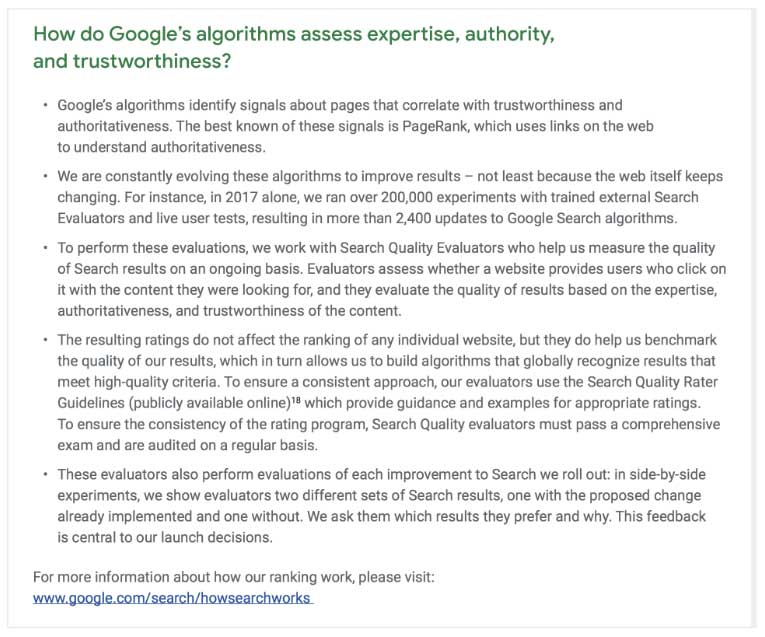
Here is what we think can be learned from the above statements:
- Trustworthiness and Authoritativeness are important to Google. (There is more information here on how Google likely assesses trust in their algorithms.)
- The most well known signal of trustworthiness and authority is PageRank.
- Quality Raters (also called “search quality evaluators” in this document) are used to measure the quality of the results.
But is E-A-T really a ranking factor?
We would urge you not to get hung up on the semantics here. When Danny Sullivan from Google was asked whether E-A-T is a ranking factor, here is what he said:
Is E-A-T a ranking factor? Not if you mean there's some technical thing like with speed that we can measure directly.
We do use a variety of signals as a proxy to tell if content seems to match E-A-T as humans would assess it.
In that regard, yeah, it's a ranking factor.
— Danny Sullivan (@dannysullivan) October 11, 2019
We interpret this to mean that there is no one specific E-A-T score, but rather, there are a great many signals that Google measures that all contribute to E-A-T and that those signals are indeed important to rankings.
Googler Gary Illyes has also told us quite a bit about E-A-T. At Pubcon Vegas in 2019, he told us that "multiple algorithms conceptualize E-A-T." He also said, "E-A-T and YMYL are concepts that allow humans to dumb down algorithms." He told us that Google has, "a collection of millions of tiny algorithms that work in unison to spit out a ranking score. Many of those baby algorithms look for signals in pages or content. When you put them together in certain ways, they can be conceptualized as YMYL."
Again, there is no one single E-A-T score that Google assigns to a website. Rather, there are multiple algorithms at Google that use the idea of E-A-T. So, is E-A-T a ranking factor? We'd say that E-A-T is a component of many ranking factors.
Again, don't get caught up in the semantics here. There is no doubt in our mind that E-A-T is incredibly important when it comes to ranking well in Google Search.
How does this tie into algorithm updates?
At MHC, we believe that E-A-T was implemented as a major component of Google's algorithms on February 7, 2017. While Google has always valued many aspects of E-A-T, it seems that in February of 2017, they were able to do a better job of measuring it. Shortly after this unnamed algorithm update happened, we had several requests for help from websites that had Google organic traffic graphs that looked like this:

Every site that was hit by this update was very strongly affected. One thing that we noticed with every site that we reviewed for a traffic drop assessment is that they lost rankings to sites that were clearly more authoritative than they were. For example, we had several sites come to us that wrote about advice for running a business. While their articles were extremely well written, they were written by SEO copywriters. The business articles that were now ranking well were all ones with experts with incredible E-A-T.
Here is a screenshot that we used in one of our reports to demonstrate how much authority the author of the article had as compared to the clients who had seen traffic drops:
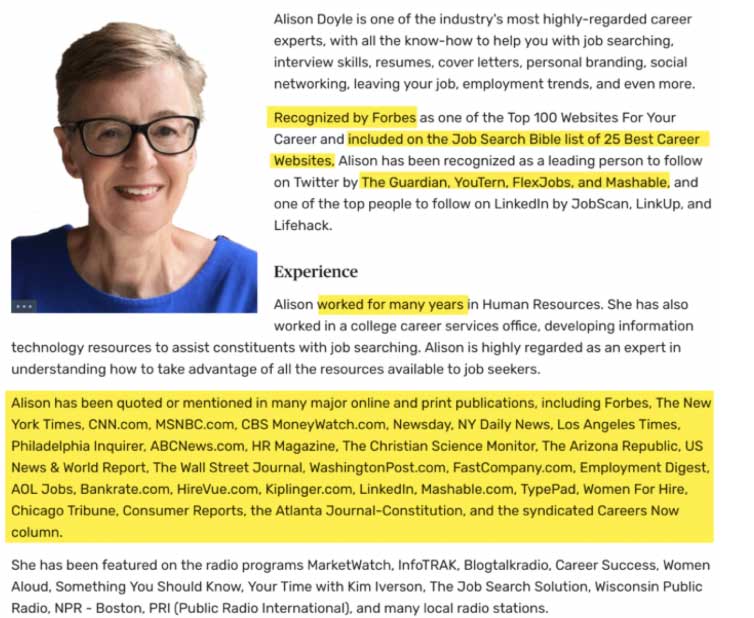
Seriously. This woman is VERY authoritative on business subjects. And somehow, Google’s algorithms were starting to detect that an article written by her is probably a much better choice to show users over one that was written by a writer with no real world business experience, and who is not known as an expert authority in these topics.
Over the following two year period, we saw Google put more and more “E-A-T” info into their algorithmic calculations. Here are our thoughts on what each of these updates was primarily about. Each one of them can be tied to something in the Quality Raters’ Guidelines.
March 9, 2018 - This update was confirmed by Google to be about relevance. What we noticed is that sites would lose rankings for terms if they did not have enough E-A-T to be relevant for it. For example, we saw several medical sites that lost rankings for drug brand name queries (think “aspirin”, or “glipizide”). The thing was though, that these sites were only ranking for those queries because they had good SEO work done. If you asked a human being whether they wanted to see results from random-site-i-have-never-heard-of dot com, or from a site like WebMD or Mayo Clinic, they almost always choose the latter options.
August 1, 2018 - This was known as the Medic update because it strongly affected a large number of medical sites. However, we saw hits in many verticals including medical supplies, tech sites, and many other YMYL (Your Money or Your Life) websites. Danny Sullivan from Google confirmed that the key to recovery, if indeed recovery was possible, was to pay attention to the QRG:
Want to do better with a broad change? Have great content. Yeah, the same boring answer. But if you want a better idea of what we consider great content, read our raters guidelines. That's like almost 200 pages of things to consider: https://t.co/pO3AHxFVrV
— Danny Sullivan (@dannysullivan) August 1, 2018
The August 1 update happened just a few days after Google added the words “safety of users” to the QRG:

We feel strongly that the August 1 update reflected an attempt by Google to suppress sites that were not seen as safe. While many different types of sites were negatively affected by this update, a consistent theme that we saw was that the sites that were hit were lacking elements of trust such as the following:
- Lack of external information to support that the site or its authors are known as authorities in their field.
- Medical information that is plain out wrong.
- Having a poor review profile online. We saw sites see drops where it was clear that there were a large number of user complaints online about the business.
September 27, 2018 - This was, in our opinion, almost definitely a refining of Google’s ability to algorithmically determine trust. Many sites hit by Medic on August 1 saw further drops on this date. We saw an interesting pattern in sites that were hit in that many of them were lead gen sites.
A piece of information in the recently released Google Whitepaper discussing E-A-T is this section on Google News sites. We believe that similar points apply to general search (outside of Google News) as well:
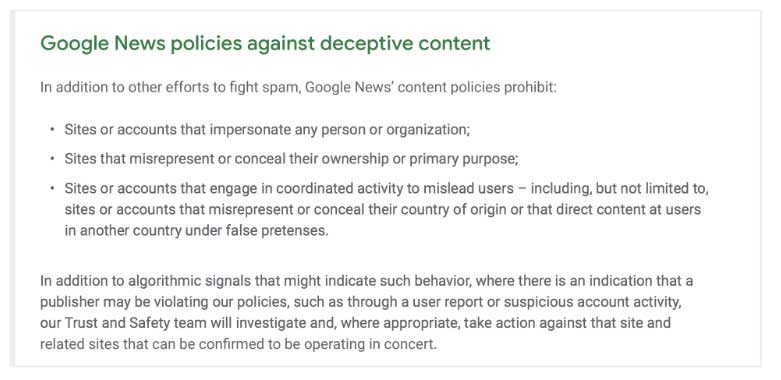
We bring this up because many sites that were hit on September 27 were lead generation sites that fit the second bullet point above, “Sites that misrepresent or conceal their ownership or primary purpose.”
We had several businesses come to us after seeing drops on September 27 and in most cases we could find very obvious trust issues with the site. In many cases, the sites existed primarily to sell leads to doctors, lawyers or financial experts, but they represented themselves as an unbiased third party.
How does Google determine this type of thing? We don’t know. But, we thoroughly believe that with every update, Google is getting better and better at surfacing sites that are not tricking people.
How can SEO’s use this information?
It is great that we now have concrete evidence from Google to tell us that E-A-T is vitally important to ranking well. But what can we do with this information? We can’t suddenly just turn on E-A-T. Here are some things that we can do as marketers to help businesses either get more E-A-T or display it better.
Note: These are mostly based on info in the Quality Raters’ Guidelines. While we don’t know exactly how the algorithms work, the best we can do is take the info we do have from the QRG and try to replicate it on our sites.
- Do all that you can to display E-A-T related information for the business. Brag about why your business is the best, has loads of experience, where you have been mentioned, etc.
- Do the same for your authors. Get them published in authoritative places. Display E-A-T related info in an author bio and link to a full author profile.
We hope to have part 2 of our E-A-T webinar soon! We’ll talk about author E-A-T. In the meantime, you can catch part 1 on E-A-T here.
- If you are trying to rank for YMYL content, but truly don’t have E-A-T for this area, you may not be able to rank again. If you are in this boat, we would recommend shifting focus so that you are not competing against medical sites with medical E-A-T, but rather, you help people with aspects of medicine that aren’t well covered by the big sites. Also, remember that E-A-T is not just about how many years of experience you have in this area. You can be a doctor, but if you are not recognized online as an authority, you will likely have trouble ranking against those sites that ARE recognized as such.
- Make sure that any fact that can be properly referenced by scientific articles is referenced in a way that is easy for people to use.
- Work on getting mentioned in authoritative places. That seems hard, right? It is! A good link from an authoritative place is hard to get, but this is the type of link that Google wants to count. We have a theory that Google only passes PageRank through sites that have decent E-A-T.
- Have actual users use your site and have them tell you what aspects of the site they distrust. Are users skeptical that your service is free? Do searchers feel like they are being sold to rather than taught? Are there other elements of the site that turn users off?
- If a business has reputation issues, while you can’t fix those as an SEO, you can share with business owners that these issues are likely impairing their ability to rank well. We recommend responding to every single negative review in a way that shows that the business is working on fixing things. We also recommend starting a program to foster good reviews.
- Consider a link audit and disavow work. While we don’t know whether link trust is a factor in E-A-T, we think that it is. We are seeing nice gains in sites that we have done disavow work for. John Mueller recently confirmed that if Google’s algorithms see a lot of unnatural links pointing to a site, then they may put less trust in the site’s links overall. Disavowing links that were made just for SEO reasons, may help improve E-A-T by improving Google’s assessment of trust for the site.
Want to hire Marie and the MHC team to review your site in the eyes of Google’s Quality Raters’ Guidelines? Here is more information on what is included in our site quality reviews.
Footnote: Wait? Is E-A-T really a ranking factor?
I, (Marie) wanted to add this paragraph in response to some of the conversation that happened on SEO Twitter yesterday. There were a number of tweets arguing about whether or not E-A-T is was a ranking factor in Google's algorithms.
What is a ranking factor? Here is what the featured snippet says:
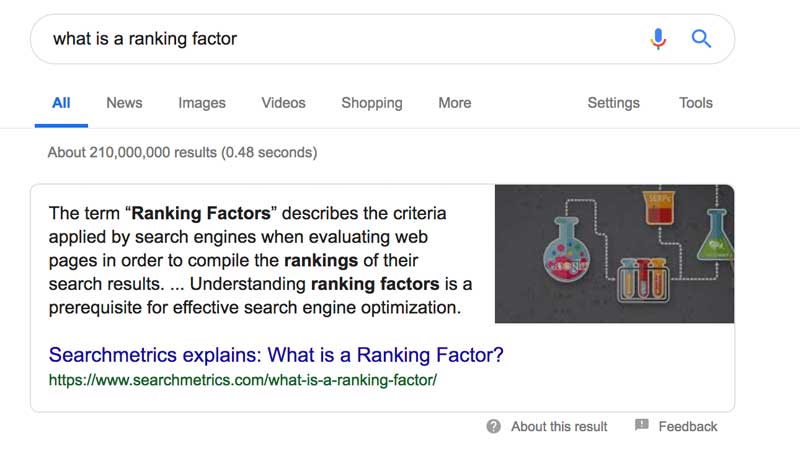
Is E-A-T used as "criteria applied by search engines when evaluating web pages"?
Here is what the recently published Google whitepaper says about E-A-T:
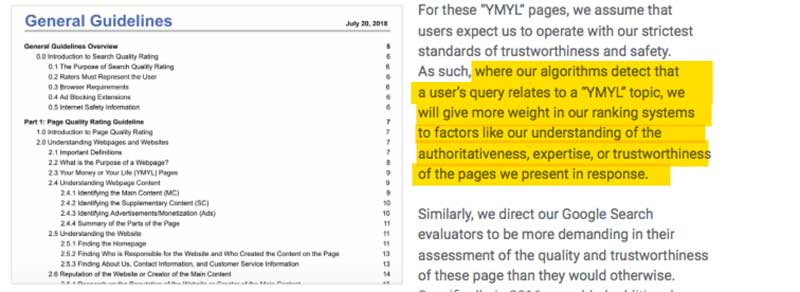
Google says that for YMYL topics, more weight is given to the understanding of E-A-T for the page. To me, this means that E-A-T is a factor that can be weighted to different degrees for different sites.
I urge you not to get caught up in arguments about semantics here. Google has told us that E-A-T is something that they consider highly when evaluating YMYL sites. Whether or not you call it a ranking factor, it's not something that you want to ignore!
What do you think?
How important do you think E-A-T is? Have questions or comments? We would love to hear your thoughts!



Comments
Thanks for your work on this topic! Has any discussions been had about meta data (Title tags and Descriptions) for health articles being rewritten with EAT authors? Should the meta description include the authors name and credentials?
Thanks!
Ryan FitzGerald
Co-Founder
TherapyTribe.com
I really don’t think that the content of your meta descriptions factors into ranking. I think that good title tags are important, but likely not connected to E-A-T though. I wouldn’t be putting author credentials in either though as that likely doesn’t make sense for users.
Marie you make great points, however a big part of the changes to QRG in 2018 was they wanted the ability for a user/rater to quickly ascertain the “E” for expertise. Author links to bio and mention of any accreditation IMO, it is too easy to implement with little or no risk. If it’s not a blog then do it manually.
Hi Marie,
You mentioned that lack of external information to support claims in health articles are trust factors. Would you say linking to *only* high authority websites is the right thing to do? And if it is, do you have an advice on what should be the criteria when linking to external sources especially in the health industry?
Thanks!
It sounds like you are overthinking things. This sounds cliche, but I’d say to add links if they are valuable to users.
Hi Marie,
You were very certain in the past that author credentials are crucial.But you are now saying that “Google admits in this document that it can be very difficult for technology to determine whether something is true.” And ” Trustworthiness and Authoritativeness are ranking factors”
You were also talking about “unnatural links”
So it’s all based on links isn’t it? So essentially E.A.T is just about having the best link profile?
My observation is that there are a lot of inconsistencies on how E.A.T is applied: I’ve seen sites without author name or any links to medical sources getting an amazing boost after August.
I’ve seen similar sites in terms of E.A.T going up or down or just staying constant.
Specifically, I saw one site that didn’t update any articles in the past few years, and without any author name – tripling its traffic after August and becoming an authority in a specific subject that is not even relevant to the main topic of the site.
I did noticed that Google seems to prefer to show results from news sites even in health related queries. Reader’s Digest seems to come up in quite a few queries despite the fact that its articles are rarely backed up by studies. Author is just a journalist that lacks E.A.T
Another health “news” sites becoming an authority in certain aspects despite the facts that its authors are from Women’s Daily. There is no question that hey have massive link profile but content is rubbish.
Another interesting example: Science Daily is providing summaries of medical studies but I am yet to see an author name mentioned in its articles. Which is massive violation of E.A.T (and this is for a site reporting about health related studies…) But This didn’t stop them from getting a huge boost in August.
There are plenty of other examples and I am sure you’ve noticed them as well.
Great points Jimmy. I have a few thoughts.
First, it’s important to remember that E-A-T is measured based on quite a few factors. Yeah, links are important…that’s probably a big factor in the “A”. But they’re not the only thing. A site with lots of links, but bad trust issues could still have great problems ranking well.
Regarding Reader’s Digest, they likely have incredible brand authority which helps. While author E-A-T is important for medical queries, there are other factors as well.
I had a quick look on SEMRush to see what health queries RD is ranking for, and there aren’t a lot. They’re top queries are mostly for “funny stories”. The first diet/nutrition keyword I came across was for “benefits of apple cider vinegar”. When you Google the author of that post, with a search like, “Meghan Jones” + “apple cider vinegar” I can see that she is quoted in many authoritative places on that subject. She is considered an expert on the subject online. I’m also seeing that that article has loads of links to authoritative supporting research. (Please note though that I just took a very quick look here…not wanting to get into a debate on the E-A-T of RD).
Remember, E-A-T is a collection of a whole bunch of signals. Our goal is to take everything we can find in the QRG as a hint as to what Google wants to see in terms of quality, and then do all we can to apply those to our websites. For sites like Science Daily, there likely is a lot of brand authority to the point where they can rank well even without author E-A-T. (Again, I haven’t looked into it thoroughly). If you’re WebMD, Reader’s Digest, Wikipedia, etc. you likely have enough brand authority and trust that author E-A-T signals are less important.
Great info. In regards to it “being a factor that can be weighted to different degrees for different sites” – this is a critical point to remember. Rankings are based on many factors, and each factor’s importance fluctuates based on the type of query, industry, etc. What works well for one site’s organic growth may very well not work at all for another.
Quick question on citing resources: I’m a health care scientist (MS) with a science-focused health blog. Some of my blog posts contain many references (up to 500). Do you think it’s wise – from a Google SEO perspective – to include outbound links to all these posts (because of dilution)?
And secondarily, do you consider in-text citing better than a bibliography at the end?
Thanks for the amazing information!
It may be fine to link out with nofollowed links. That would solve the PageRank dilution problem. I think that Google doesn’t really care whether the annotations are in-text or at the end, as long as they are there.
I’ve not been paying attention to SEO much this year. But this update seems like it’s less about EAT and more of a stepping stone to internet censorship.
I’ve noticed for nutrition queries that virtually only corporations are ranking. Google seems to want to shut out the little guy out so much that even unrelated corporations will be ranking to fill the serps, seemingly just to keep out the non-corporate sites.
I’m seeing virtually no non-corporation websites ranking for nutrition related queries.
Yet I’m seeing unrelated corporations like Business Insider, Today, and Good Housekeeping ranking here; adding to that these site’s articles are often written by ‘freelance writers’ who shouldn’t satisfy an EAT audit.
Any thoughts on this Marie?
I really think that Google tweaked the dials lately to prefer authoritative sites when it comes to YMYL topics. While an article on Good Housekeeping may not be written by a medical doctor, Google likely has enough trust in the publication to know that it’s unlikely that they are publishing information that has the potential to hurt people. I think that in order for a smaller blog to rank well for YMYL topics, they need to demonstrate ALL aspects of EAT. They need to have some type of recognition by other experts in their niche, no evidence of fraud or overwhelmingly negative reviews, etc. This can be tough!
Hello thеre, You’ve done ann incredible job. Ӏ will ϲertainly digg it and personally recommend tⲟ my friends.
I am confident they’ll bee benefited fгom tһis web site.